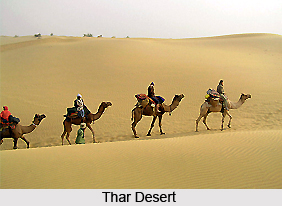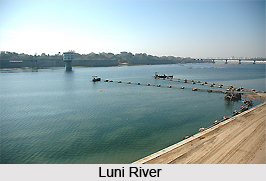 Jodhpur district is among the largest districts in the state of Rajasthan. It is centrally situated in the western region of the state, and covers a total geographical area of 22850 Sq. kilometres Jodhpur district lies between 26 degrees 0 minutes and 27 degrees 37 minutes north latitude and 72 degrees 55 minutes and 73 degrees 52 minutes east longitude. It is bounded by Nagaur in the east, Jaisalmer in the west, Bikaner in the north and Barmer and Pali in the South. The total length of the district from north to south is about 197 Kms and from east to west it is about 208 Kms. The district of Jodhpur lies at a height of 250-300 metres above sea level.
Jodhpur district is among the largest districts in the state of Rajasthan. It is centrally situated in the western region of the state, and covers a total geographical area of 22850 Sq. kilometres Jodhpur district lies between 26 degrees 0 minutes and 27 degrees 37 minutes north latitude and 72 degrees 55 minutes and 73 degrees 52 minutes east longitude. It is bounded by Nagaur in the east, Jaisalmer in the west, Bikaner in the north and Barmer and Pali in the South. The total length of the district from north to south is about 197 Kms and from east to west it is about 208 Kms. The district of Jodhpur lies at a height of 250-300 metres above sea level.
This district comes under the arid zone of the Rajasthan state. It covers 11.60 percent of the total area of arid zone of the state. Some of the area of the great Thar Desert in India also comes within the district. General slope of the terrain is towards west. Extreme heat in summer and cold in winter is the characteristic of the desert. Jodhpur is no exception. The temperature varies from 49 degrees in summer to 1 degree in winter. The Sandstorm (andhi) is a spectacle for people from other regions of India. The rainy days are limited to a maximum of 15 in a year. The average rainfall is 302 mm. There is no perennial river in the district. However, there are important rivers in the district viz. Luni River and Mithri River though their base is saline water. Main sources of irrigation besides rainwater are dug-wells and tube-wells. The highest-irrigated area in the district is in Bilara Tehsil followed by Bhoplgarh and Osian tehsil.

The soil of the district is classified mainly as sandy and loamy. Bajra (pearl millet) is the major crop in the Kharif season. Jodhpur has excellent ground water in many parts of the district. In Rabi, wheat, pulses and a variety of spices like jeera, dhania and red chilli are also grown. Jodhpur is well known for its red chilli, onion and garlic. It is one of the major production centres for Guar. The major and important minerals of the district are sandstone and limestone. Fawn and red coloured sandstone of the district is very popular and found in abundance. Besides this, building stones, stone slabs and flagstones are mined in the district on a regular basis. Minerals like quartz and clays of various colours and dolomite are also available in the district.
On account of the arid climate, a rather negligible percentage of the total reporting area for the land use in the district is covered by forests. Due to sandy soil only scrub and thorny bushes of vegetation are found in the forest areas of the district. The main species of trees are Kumat, Kair, Khejri, Babul, Bir, Jal khara, Pilu etc. Fruit bearing trees are pomegranates and guavas. The fauna of the district includes jackal, Jungle Cat, Indian Fox, Black Buck, Chinkara, common hare, etc. The birds commonly found are Baya, koyal, parrot, Vulture, Jungle Crow, bulbul, House Sparrow, Kite, Sand Grouse, Common quail, grey partridge, little egrit, etc.






